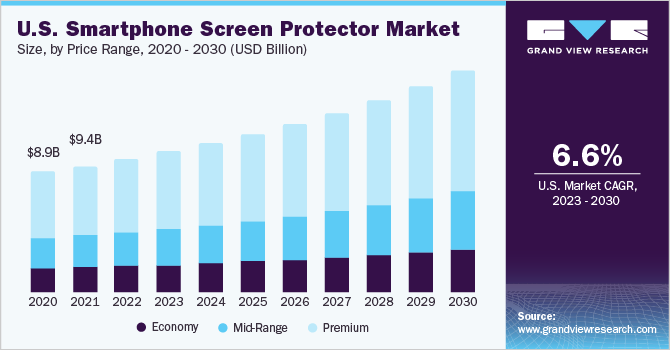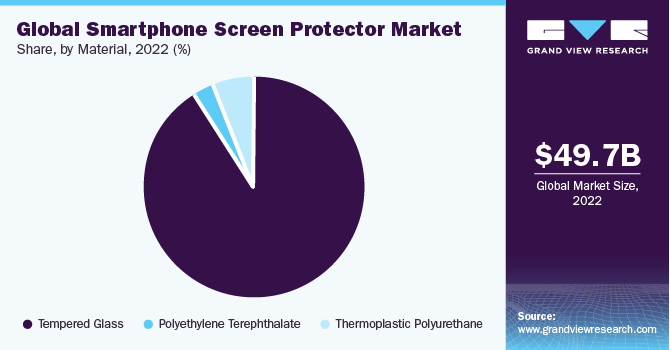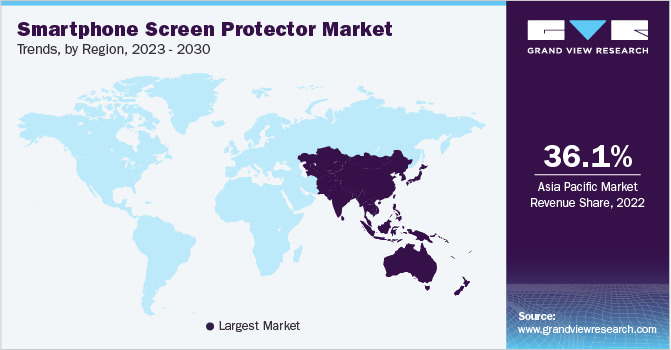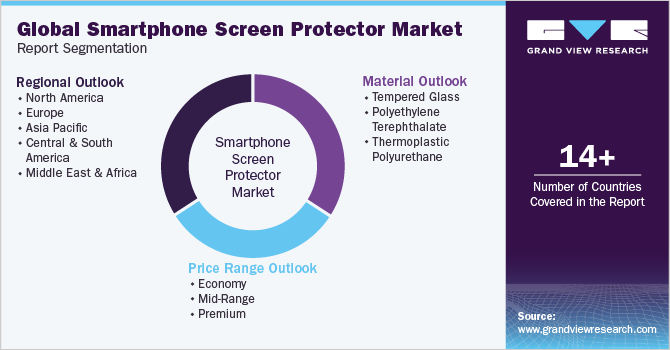- Home
- »
- Clothing, Footwear & Accessories
- »
-
Smartphone Screen Protector Market Size, Share Report, 2030GVR Report cover
![Smartphone Screen Protector Market Size, Share & Trends Report]()
Smartphone Screen Protector Market Size, Share & Trends Analysis Report By Material (Tempered Glass, Polyethylene Terephthalate), By Price Range (Economy, Mid-Range, Premium), By Region, And Segment Forecasts, 2023 - 2030
- Report ID: GVR-1-68038-043-9
- Number of Report Pages: 80
- Format: PDF, Horizon Databook
- Historical Range: 2017 - 2021
- Forecast Period: 2023 - 2030
- Industry: Consumer Goods
Report Overview
The global smartphone screen protectors market size was estimated at USD 49.73 billion in 2022 and is expected to grow at a compound annual growth rate (CAGR) of 6.9% from 2023 to 2030. The demand for luxury goods, such as smartphones, is driven by the world's rapidly growing per capita income, which is aiding and promoting the market expansion of smartphone screen protectors. Following the recent COVID-19 outbreak, many regulatory agencies imposed restrictions and forced lockdowns, which resulted in the temporary suspension or reduction of activities in several businesses. This is also true of the global market for smartphone screen protectors, and this factor is anticipated to have a significant detrimental effect on the industry's revenue growth.

The high expenses related to installing and maintaining these devices are another aspect that can restrain the global market's revenue growth over the course of the projected year. The advancements in smartphone display technologies, such as LED displays, Super AMOLED, IPS-LCD, and infinity displays, have resulted in higher costs for premium smartphones.
Users are growing increasingly cautious about protecting these expensive devices, as any damage to the screen can be costly to repair or replace. This has led to an increase in the sales of such products as a preventive measure against screen damage. The demand for refurbished and second-hand smartphones is increasing due to their lower costs compared to brand-new devices. As users purchase these devices, they may seek additional protection for the screens, driving the sales of smartphone screen protectors.
Price Range Insights
The mid-range price segment is expected to register the fastest CAGR of 7.4% from 2023 to 2030. This premium price category dominated the market with 55.9% of the revenue share in 2022. These premium cell phone covers often offer additional features and benefits beyond basic protection and are gaining increased acceptance among the millennials that are opting for premium models of smartphones.
These premium protectors are often made with high-quality materials that offer superior durability and protection for the phone's screen. They are designed to withstand scratches, impacts, and other potential damage. Additional features such as anti-glare properties, anti-fingerprint coatings, or enhanced touch sensitivity. These features improve the user experience by reducing glare, and smudges, and improving the responsiveness of the touch screen.
Material Insights
The tempered glass segment accounted for the largest revenue share of 90.60% in 2022. The growth can be attributed to the advantages of using glass over PT and TPU. Glass offers superior defense against dings and high-impact damage. Tempered glass has gained widespread acceptance among the masses as a mobile phone screen protector because of its outstanding multi-layered and shock-absorbing properties. While in use, the phone feels like genuine glass because of the oleophobic layer on the tempered glass, which eliminates fingerprints. These glasses are anti-reflective, reduce glare, and have better light transmission than other alternatives. The consistent usage of tempered glass by smartphone consumers will drive market trends for such products.
The tampered glass segment is expected to witness the fastest growth at a CAGR of 7.1% from 2023 to 2030. Tempered glasses are readily available in the market. They can be easily found in various retail outlets, online stores, and smartphone accessory shops, catering to the high demand and popularity among consumers.The combination of superior protection, clarity, touch experience, and easy availability has contributed to the widespread popularity of tempered glasses in the present-day era.
They have become an essential accessory for smartphone users who prioritize safeguarding their devices' screens. Also, nowadays screen protector brands work closely with smartphone brands to create customized designs that align with the aesthetics and branding of the devices. This includes matching the protector's color, finish, and overall look to complement the smartphone's design language.
In October 2022, Belkin International, Inc., a leading American consumer electronics and networking company, introduced Apple iPhone 14 series screen protectors and accessories. The ‘TemperedGlass Treated Screen Protector’ comes with an easy align tray for proper alignment and bubble-free usage and also has an antimicrobial agent to stop the formation of bacteria and dust.

The thermoplastic polyurethane segment is projected to register a CAGR of 5.5% from 2023 to 2030. One of the advantages of utilizing this type of screen protector is that it resists scratches, oil accumulation, and grease. This flexibility also allows the screen protector to self-heal, which is important when utilizing these types of products. Because of the material's physio-chemical properties, these screen protectors are suitable for curved displays and in-screen fingerprints, both of which are becoming increasingly frequent in modern devices.
Regional Insights
North America is expected to witness a CAGR of 6.3% from 2023 to 2030. Due to the increasing acceptance of premium technology high-price smartphones, the North America region is expected to witness growth during the forecast period. Additionally, rising demand for protective smartphone accessories, together with rising consumer disposable income, is likely to result in higher growth during the projection period.

The U.S. smartphone screen protector market was valued at 9.90 billion in 2022 and is estimated to grow at a CAGR of 6.6% from 2023 to 2030. The popularity of screen protectors extends to a broad consumer base in the U.S. It encompasses both tech-savvy individuals who are knowledgeable about smartphone accessories and the general consumer market that seeks basic protection for their devices. Popular brands in the U.S.like Corning Inc., Belkin International, Inc., and others often partner with global smartphone brands like Apple, Samsung, and Xiaomi to introduce upgraded shockproof protection in films and back covers for smartphones.
These partnerships aim to enhance the visibility and market reach of the products among consumers. Corning Inc. established a partnership with prominent global smartphone manufacturer Samsung Electronics Co., Ltd. in January 2023 for the use of Corning Gorilla Glass Victus's second version in their upcoming Galaxy flagship models. An updated version of the original Gorilla Glass Victus, the Gorilla Glass Victus 2, provides better drop performance on challenging surfaces like concrete.
Europe accounted for a market share of 23.52% in 2022 and is expected to witness a CAGR of 6.9% from 2023 to 2030. The increasing reliance on smartphones and gadgets for work and education purposes in the UK has resulted in a greater emphasis on protecting these devices. Professionals and students understand the importance of uninterrupted productivity and avoiding disruptions caused by screen damage. This awareness drives the demand for smartphone screen protectors in the UK.
Asia Pacific is expected to witness the fastest CAGR of 7.9% from 2023 to 2030. Increasing smartphone sales, particularly in developing markets like India and China, are likely to fuel industry expansion. The increased demand for smartphones manufactured by Chinese companies like Xiaomi Inc. and Oppo Electronics Corp can indeed contribute to the growth of the smartphone screen protector industry. As these companies gain popularity and expand their market share, more consumers will be purchasing their smartphones, leading to a greater need for screen protectors.
Brands have developed protective screens with antimicrobial coatings that help inhibit the growth of bacteria and viruses on the device's surface. These coatings can reduce the risk of transmission and provide users with an added layer of protection. The COVID-19 pandemic has heightened concerns about surface transmission, including through frequently touched devices like smartphones and tablets.
The China smartphone screen protector industry was valued at 11.66 billion in 2022 and led the overall revenue share in the Asia Pacific market in 2022. The Kare Lab, a prominent supplier of medical-grade protective gear to hospitals and leading institutes worldwide launched an anti-microbial and anti-viral screen protector for iPhones and iPads in August 2022. This product was launched to curb the formation of effective viruses such as the Coronavirus during the COVID-19 outbreak in China.
Key Companies & Market Share Insights
The market includes both international and domestic participants. Key players focus on strategies such as innovation and new product launches in retail about natural products to enhance their portfolio offerings in the market.
-
In February 2023, Belkin International, Inc. introduced the ‘ScreenForce TrueClear Curve’ screen protectors of the Samsung Galaxy S23 series. By obtaining Samsung's approval, Belkin's screen protectors for the Galaxy S23 series are recognized as authorized accessories for these devices.
-
In February 2023, Gadgetshieldz, a leading mobile skins, and screen protector brand in India, introduced their Tempered Glass screen guards range under their sub-brand X.Glas. This new offering reflects their commitment to providing high-quality and superior screen protection options to consumers.
-
In March 2021, InvisibleShield released two screen protectors for the iPhone 12 family, both of which are made of an innovative material known as D3O. It's a type of non-Newtonian fluid, according to the organization.
Some prominent players in the global smartphone screen protector market include:
-
IntelliARMOR
-
AZ Infolink Private Ltd.
-
Halloa Enterprise Co. Ltd.
-
ZAGG Inc.
-
Belkin International, Inc.
-
Corning Inc.
-
Ryan Technology Co. Ltd.
-
NuShield Inc.
-
Xtreme Guard
-
Free S.speed International Co., Ltd.
-
Clarivue
-
Jiizii Glass
-
Protek
-
FeYong Digital Technology Limited
-
Shenzhen Yoobao Technology Co. Ltd.
Smartphone Screen Protector Market Report Scope
Report Attribute
Details
Market size value in 2023
USD 52.66 billion
Revenue forecast in 2030
USD 84.96 billion
Growth rate
CAGR of 6.9% from 2023 to 2030
Base year for estimation
2022
Historical data
2017 - 2021
Forecast period
2023 - 2030
Report updated
July 2023
Quantitative units
Revenue in USD billion, CAGR from 2023 to 2030
Report coverage
Revenue forecast, company ranking, competitive landscape, growth factors, trends
Segments covered
Material, price range, region
Regional scope
North America; Europe; Asia Pacific; Central & South America; Middle East & Africa
Country scope
U.S.; Germany; UK; China; India; Japan; South Korea; Brazil
Key companies profiled
IntelliARMOR; AZ Infolink Private Ltd.; Halloa Enterprise Co. Ltd.; ZAGG Inc.; Belkin International, Inc.; Corning Inc.; Ryan Technology Co. Ltd.; NuShield Inc.; Xtreme Guard; Free S.speed International Co., Ltd.; Clarivue; Jiizii Glass; Protek; FeYong Digital Technology Limited; Shenzhen Yoobao Technology Co. Ltd.
Customization scope
Free report customization (equivalent up to 8 analysts working days) with purchase. Addition or alteration to country, regional & segment scope.
Pricing and purchase options
Avail customized purchase options to meet your exact research needs. Explore purchase options
Global Smartphone Screen Protector Market Report Segmentation
This report forecasts revenue growth and provides an analysis of the latest trends and opportunities in each of the sub-segment from 2017 to 2030. For this study, Grand View Research has segmented the smartphone screen protector market report based on material, price range, and region:

-
Material Outlook (Revenue, USD Billion, 2017 - 2030)
-
Tempered Glass
-
Polyethylene Terephthalate
-
Thermoplastic Polyurethane
-
-
Price Range Outlook (Revenue, USD Billion, 2017 - 2030)
-
Economy
-
Mid-Range
-
Premium
-
-
Regional Outlook (Revenue, USD Billion, 2017 - 2030)
-
North America
-
U.S.
-
-
Europe
-
Germany
-
UK
-
-
Asia Pacific
-
China
-
India
-
Japan
-
South Korea
-
-
Central & South America
-
Brazil
-
-
Middle East & Africa
-
Saudi Arabia
-
-
Frequently Asked Questions About This Report
b. The global smartphone screen protector market size was estimated at USD 49.73 billion in 2022 and is expected to reach USD 52.66 billion in 2023.
b. The global smartphone screen protector market is expected to grow at a compounded growth rate of 6.9% from 2023 to 2030 to reach USD 84.96 billion by 2030.
b. The tempered glass segment accounted for a market share of 90.60% share of the global revenue in 2022. The growth of the market can be attributed to the advantages of using glass over PT and TPU.
b. Some key players operating in the smartphone screen protector market include IntelliARMOR; AZ Infolink Private Ltd.; Halloa Enterprise Co. Ltd.; ZAGG Inc.; Belkin International, Inc.; Corning Inc.
b. Key factors that are driving the market growth include desire for luxury goods, such as current smartphones, is being driven by the world's fast expanding per capita income, which is aiding and promoting the market expansion of smartphone screen protectors.
Share this report with your colleague or friend.
![gvr icn]()
NEED A CUSTOM REPORT?
We can customize every report - free of charge - including purchasing stand-alone sections or country-level reports, as well as offer affordable discounts for start-ups & universities. Contact us now
![Certified Icon]()
We are GDPR and CCPA compliant! Your transaction & personal information is safe and secure. For more details, please read our privacy policy.
We are committed towards customer satisfaction, and quality service.
"The quality of research they have done for us has been excellent."





